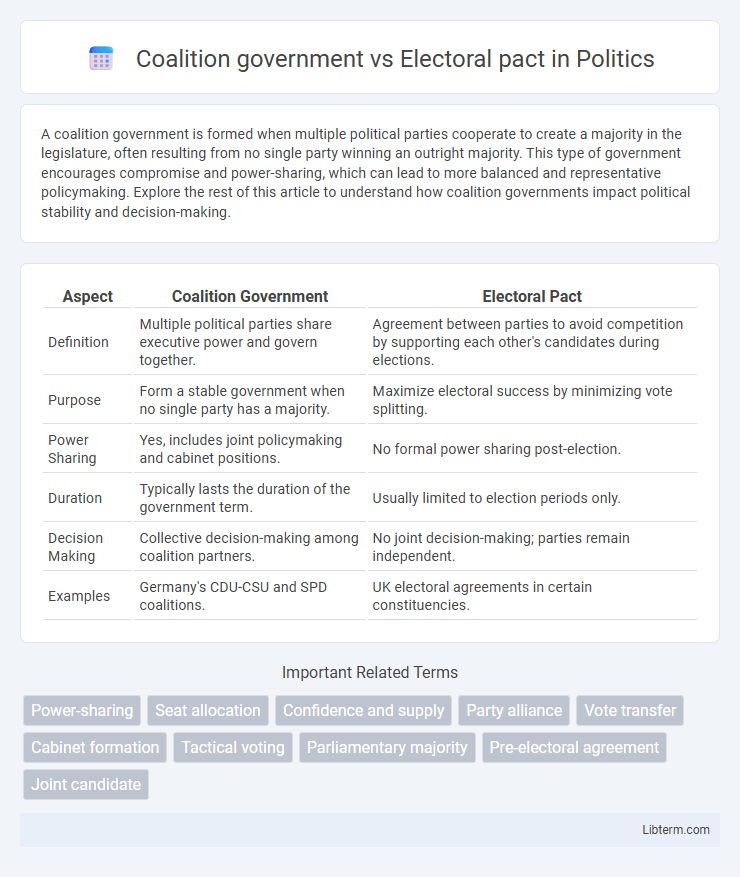A coalition government is formed when multiple political parties cooperate to create a majority in the legislature, often resulting from no single party winning an outright majority. This type of government encourages compromise and power-sharing, which can lead to more balanced and representative policymaking. Explore the rest of this article to understand how coalition governments impact political stability and decision-making.
Table of Comparison
| Aspect | Coalition Government | Electoral Pact |
|---|---|---|
| Definition | Multiple political parties share executive power and govern together. | Agreement between parties to avoid competition by supporting each other's candidates during elections. |
| Purpose | Form a stable government when no single party has a majority. | Maximize electoral success by minimizing vote splitting. |
| Power Sharing | Yes, includes joint policymaking and cabinet positions. | No formal power sharing post-election. |
| Duration | Typically lasts the duration of the government term. | Usually limited to election periods only. |
| Decision Making | Collective decision-making among coalition partners. | No joint decision-making; parties remain independent. |
| Examples | Germany's CDU-CSU and SPD coalitions. | UK electoral agreements in certain constituencies. |
Understanding Coalition Governments
Coalition governments form when multiple political parties join forces to create a majority in parliament, sharing power and policy responsibilities to govern effectively. These governments require negotiation and compromise, aiming for stability and representation of diverse interests within the administration. Unlike electoral pacts, which are pre-election agreements to avoid competition between parties, coalitions function post-election to establish a working majority.
Defining Electoral Pacts
Electoral pacts are formal or informal agreements between political parties to cooperate during elections by not competing against each other in specific constituencies, aiming to maximize collective electoral success. Unlike coalition governments that involve shared governance and policy-making after elections, electoral pacts focus solely on strategic collaboration during the electoral process. These pacts can influence election outcomes by consolidating votes and preventing vote splitting among ideologically similar parties.
Key Differences Between Coalition Governments and Electoral Pacts
Coalition governments involve multiple political parties sharing executive power and jointly making policy decisions after elections, whereas electoral pacts are agreements between parties to avoid competing against each other in certain constituencies to maximize votes. Coalition governments require formal negotiations on cabinet positions and legislative agendas, reflecting a stable partnership in governance. Electoral pacts, in contrast, are often tactical and temporary arrangements aimed solely at improving election outcomes without shared governance responsibilities.
Formation Processes: Coalition vs Electoral Pact
A coalition government forms when multiple political parties negotiate and agree to share power, often combining seats to achieve a parliamentary majority, requiring formal agreements on policy and cabinet positions. In contrast, an electoral pact involves parties agreeing to cooperate during elections, usually by not competing against each other in certain constituencies to maximize votes, without immediate power-sharing arrangements post-election. The coalition formation process is more complex and institutionalized, while electoral pacts are strategic, pre-election arrangements aimed at maximizing electoral success.
Advantages of Coalition Governments
Coalition governments offer greater political stability by bringing multiple parties together to form a majority, reducing the risk of government collapse. They enhance democratic representation by ensuring diverse political views influence policy-making, reflecting a broader spectrum of voter preferences. Coalition governments foster compromise and consensus-building, which can lead to more balanced and inclusive legislation.
Benefits and Drawbacks of Electoral Pacts
Electoral pacts streamline campaigns by consolidating support behind fewer candidates, reducing vote splitting and increasing the chances of winning seats against dominant parties. However, they can limit voter choice and lead to compromises on policy positions, potentially alienating segments of the electorate who feel their interests are underrepresented. Although electoral pacts enhance strategic cooperation, they may create tensions between allied parties due to disagreements over candidate selection and shared political agendas.
Real-World Examples of Coalition Governments
Coalition governments, such as Germany's CDU/CSU and SPD alliance, involve formal partnerships where parties share executive power, unlike electoral pacts which focus solely on coordinated campaigns without power-sharing. The Indian National Congress-led coalition exemplifies a coalition government where multiple parties govern jointly to ensure parliamentary majority. New Zealand's Labour and New Zealand First coalition demonstrates how parties negotiate policy compromises to maintain stable governance within a parliamentary framework.
Notable Electoral Pact Case Studies
Notable electoral pact case studies include the 2010 UK General Election where the Liberal Democrats and the Green Party coordinated to avoid competing against each other in selected constituencies, maximizing their chances of winning seats. In India, the National Democratic Alliance (NDA) exemplifies a successful electoral pact, where multiple regional parties collaborate under a common banner to secure a parliamentary majority. Electoral pacts differ from coalition governments by focusing solely on pre-election strategies rather than post-election power sharing.
Impact on Political Stability and Governance
Coalition governments often enhance political stability by fostering power-sharing among multiple parties, leading to more inclusive decision-making and broader policy consensus. Electoral pacts, while strategically beneficial for maximizing vote shares, can result in fragile alliances that may not translate into cohesive governance, risking instability if partner parties have divergent agendas. The durability of coalition governments generally contributes to more consistent policy implementation compared to electoral pacts, which focus primarily on election outcomes rather than long-term collaboration.
Choosing the Right Path: Factors to Consider
Choosing between a coalition government and an electoral pact depends on factors such as political alignment, party strength, and long-term objectives. A coalition government involves formal power-sharing post-election, ensuring direct influence on policy but requiring high trust and compromise among parties. An electoral pact, often a pre-election agreement to avoid vote splitting, can maximize seat wins with less formal cooperation yet may limit policy impact and cohesion after elections.
Coalition government Infographic

 libterm.com
libterm.com